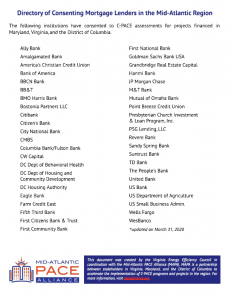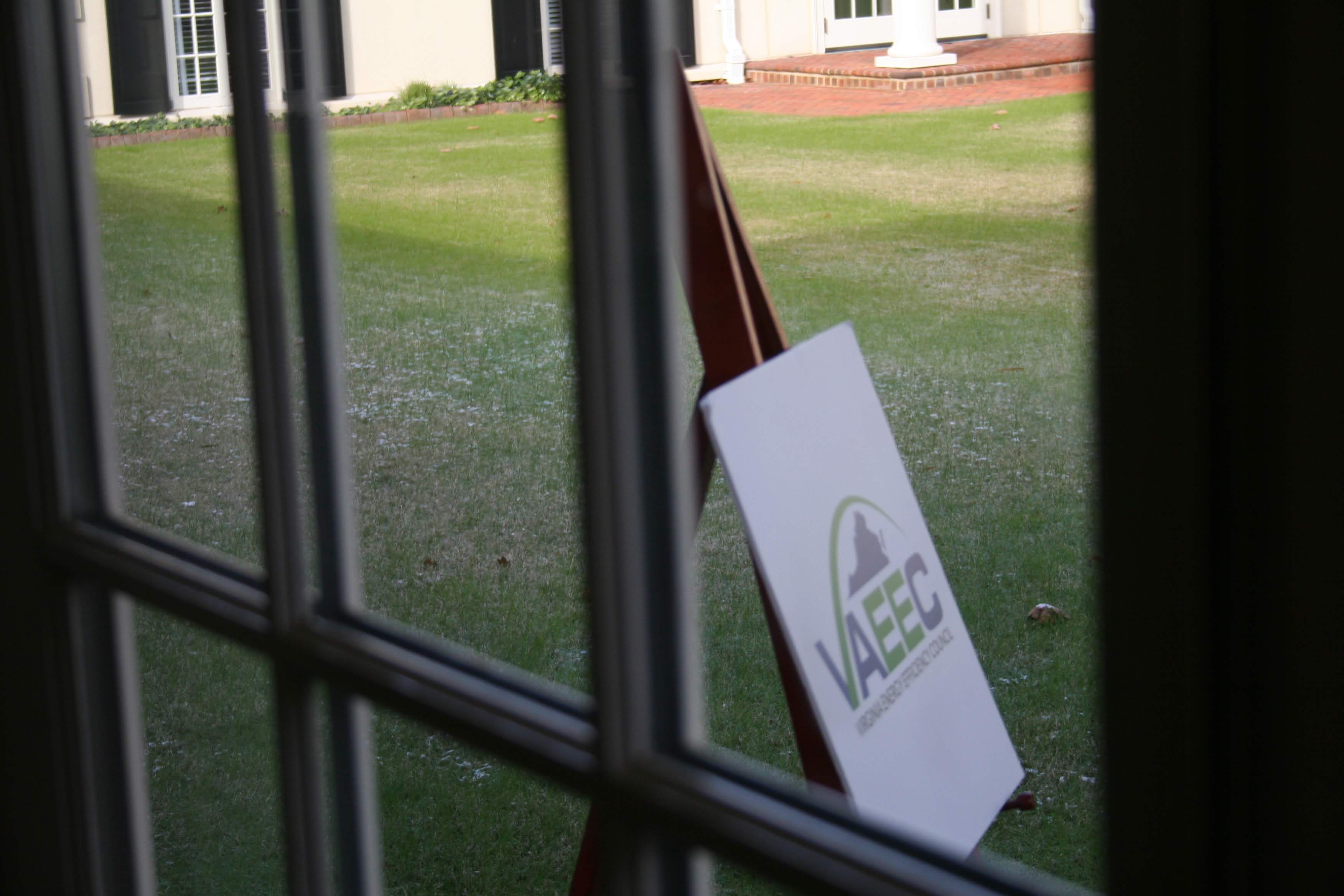Dominion’s Energy Efficiency Stakeholder Group met virtually on August 27th. They discussed a number of updates, as well as brainstormed ideas for long-term planning.
The Virginia Clean Economy Act included some changes to the stakeholder process, so two new subgroups were created, focusing on Policy and EM&V. Those groups will meet in the coming weeks.
Additionally, Dominion provided an update on how the COVID-19 pandemic has affected their DSM programs as well as an update on the improved eligibility definition for low-income programs, which we worked to change earlier this year. While the marketplace has been open the entire time, all in-person programs were suspended last spring. Dominion resumed their Non-Residential programs on May 15th and resumed all of their single-family, residential programs in June. Recently, they allowed multi-family projects to resume in their low-income programs. All low-income program providers are following federal weatherization COVID guidelines.
Following the SCC’s recent approval of all of Dominion’s Phase VIII DSM programs, the Dominion DSM team and their implementation vendors are working on preparation as they prepare to launch them in January 2021.
Dominion also provided an update on their next filing for Phase IX, which will be submitted to the SCC in December. The company received 53 program proposals from ten vendors in response to their most recent RFP. The program categories were: Non-Residential, Residential, Low-Income, Cross Program services (e.g. marketing, call center, rebate fulfillment, etc.) and “open” programs with this last category being used as a starting point for next year’s RFP.
Dominion’s EM&V vendor, DNV GL, gave a presentation on their annual EM&V report, which was filed back in May. The residential marketplace made up 51% of the energy savings from DSM programs in 2019. Through the marketplace program, 3.5 million light bulbs were purchased either online or at a retail store. The Non-Residential lighting program made up 30% of the energy savings in 2019 and the Non-Residential small business program made up 11%. All other programs each made up one percent or less of the total savings accrued in 2019. There was also a brief discussion about the upcoming EM&V proceeding before the SCC, which will take place next May. The VAEEC will be participating as a respondent in this case and has already begun working with our lawyers with the UVA Environmental and Regulatory Law Clinic in preparation.
The group concluded the day with a discussion on long-term planning. The company has hired the Cadmus Group to assist with this planning, which will help meet their mandated energy savings targets, which became law earlier this year. If you are already a member of the stakeholder group, and would like to participate in this planning process, be sure to add yourself to the long-term planning subgroup in Trello.
If you would like to participate in the Stakeholder meetings or would like to view materials, please email the meeting facilitator, Ted Knicker at ted.knicker@ipa-llc.org to learn more.
Yesterday, the SCC approved ALL of Dominion’s Demand Side Management (DSM) programs in their phase VIII filing and the updated programs in their VII filing. All programs- except the Low Income (LI) heating and cooling program- were approved for five years from January 2021-December 2025. The LI heating and cooling program was approved for three years, as stated by law, and will run from January 2021-December 2023. The updated phase VII programs can begin immediately and will end in December 2024 along with the remaining VII programs.
As a formal respondent in the proceedings, the Virginia Energy Efficiency Council (VAEEC) is incredibly excited with the progress shown in this final order. The Commission has also expressly agreed with the VAEEC that the creation of a standardized dashboard for evaluation, measurement, and verification (EM&V) reporting is necessary to determine the true effectiveness of these energy efficiency programs.
The Commission also agreed that the proposed mid-stream program should not split the incentives between the homeowners and the builders. This is a great example of how our involvement in this process is crucial. The company had agreed to the 50% split incentive in their rebuttal testimony and the Hearing Examiner recommended it to the Commission. However, the Commissioners were clearly swayed by our arguments that a split incentive did not enhance energy efficiency gains in this instance.
We’re also pleased to note that Dominion has expressed its willingness to continue working on standardizing the process for qualifying low-income projects and post-construction reporting requirements. The updated eligibility criteria that Dominion agreed to earlier this week are part of this work, though there are standardization needs that still need to be addressed.
A full list of the programs can be found here.
We are excited to announce that this week, on a call with VAEEC members and staff, Dominion Energy committed to using a definition of low income eligibility requirements that weatherization providers and VAEEC have suggested for some time. That new definition is:
A household whose annual income does not exceed 80% of the local area median income as set forth by Virginia Housing Development Authority or 60% of the state median income as determined by the Virginia Department of Housing and Community Development, whichever is greater.
This change, which Appalachian Power Company is already planning to implement, will allow weatherization providers to serve more households across Virginia. Chase Counts with Community Housing Partners stated, “This is not only a big win for vulnerable Virginian households but is also an example of Virginia’s leadership in energy equity issues.”
On June 16, 2020, the hearing examiner in the Dominion Energy DSM Proceeding (PUR-2019-00201) released his recommendations to the Commission. Overall, the report was positive, recommending that all of the programs be approved- some with modifications- at the budget requested by the company.
While the VAEEC is pleased overall with the recommendations, we are drafting comments as respondents in the case to address two outstanding issues:
- For the New Home Construction program, the hearing examiner recommends splitting the incentive between the homebuilder and the homebuyer 50/50. As we argued in our post-hearing brief, the lead actor for creating market transformation in this type of mid-stream program is the homebuilder, “who is making the design and equipment decisions necessary to achieve ENERGY STAR certification, [which] leads to more energy-efficient homes being put on the market for sale.”
- The hearing examiner stated that the VAEEC’s request to require that all future DSM applications include energy savings data and tracking metrics towards the goal in the Virginia Clean Economy Act (VCEA) was unnecessary. Instead, it was suggested that this and all other futuristic recommendations should be further explored and developed by the stakeholder group. While we do agree with this conclusion for some of our other recommendations (e.g. geo-targeting and using AMI to enhance programming options), we feel the Commission should require inclusion of key data- as related to the mandates in the VCEA- in all future filings. Without these metrics, how can the Commission and the public understand whether or not the company is making progress towards its goals?
We hope the Commission will consider these arguments as they deliberate on their decision.
One final thing to note is the section of the hearing examiner’s report on EM&V. Throughout the proceeding, the SCC staff expressed a lack of confidence in the company’s EM&V analysis. In the company’s rebuttal testimony, Mimi Goldberg with DNV GL invited Staff to meet with them in order to walk through their process and to “improve the rigor of EM&V.” During their opening statements at the virtual hearing on April 29th, the SCC staff attorney took offense to this suggestion, which they reaffirmed in their post-hearing brief, stating, “such collaboration between [Dominion Energy] and Staff would compromise Staff’s ability to critically review future DSM filings.”
In his report, the hearing examiner not only dismissed this notion of impropriety, but made the recommendation for the Commission to direct Staff to engage with the company on these issues. The recommendation also goes on to reaffirm SCC staff’s engagement in the stakeholder processes, which to date has been greatly limited.
From the hearing examiner’s report:
“Moreover, Staff working with the Company to develop more rigorous and accurate EM&V data is consistent with the requirements of § 56-596.2 C of the Code as revised by the VCEA. This Code provision directs the Company to use a stakeholder process “to provide input and feedback on . . . (iv) best practices for [EM&V] for purposes of assessing compliance with the total annual energy savings . . . .” This Code provision further provides: “[s]uch stakeholder process shall include the participation of representatives from each utility, relevant directors, deputy directors, and staff members of the Commission who participate in approval and oversight of utility efficiency programs, . . . .” I recognize that Staff working with the Company to develop more rigorous and accurate EM&V data may go beyond the requirements of the stakeholder process set forth in § 56-596.2 C. However, Staff participating in the stakeholder process addressing EM&V, but declining to otherwise work with the Company on EM&V issues, would undermine the policy directive of the General Assembly for EM&V practices to be developed in a collaborative process. Therefore, I find the Commission should direct Staff to work with the Company and others to develop more rigorous and accurate EM&V data.”
So, what are the next steps? We wait for the SCC to issue their Final Order in the case, which should happen within the next several weeks. Regardless, Dominion’s plan is to launch the approved programs in early 2021. The next virtual stakeholder meeting is anticipated to be held sometime in August.
 Social distancing did not stop Virginia’s energy efficiency industry from coming together to learn and connect at our first-ever virtual Spring Forum. Over 100 energy efficiency professionals participated in the event, which included three educational sessions, our annual member meeting with Board elections, the fifth annual Virginia Energy Efficiency Leadership Awards, and a virtual networking break. Attendees were treated to topics such as the 2020 legislation, energy data, high-performance buildings, technology, and more. We want to extend a huge thank you to our sponsors for their support and to everyone who attended.
Social distancing did not stop Virginia’s energy efficiency industry from coming together to learn and connect at our first-ever virtual Spring Forum. Over 100 energy efficiency professionals participated in the event, which included three educational sessions, our annual member meeting with Board elections, the fifth annual Virginia Energy Efficiency Leadership Awards, and a virtual networking break. Attendees were treated to topics such as the 2020 legislation, energy data, high-performance buildings, technology, and more. We want to extend a huge thank you to our sponsors for their support and to everyone who attended.
The event started off with the “2020 Legislation” session. Led by VAEEC’s Chelsea Harnish, Sen. Jennifer McClellan, and Del. Rip Sullivan discussed the monumental energy efficiency laws that passed the General Assembly earlier this year, including the Virginia Clean Economy Act (VCEA). The VCEA mandates 5% energy savings from the investor-owned utilities by 2025, marking Virginia as just the second state in the Southeast to establish a mandatory stand-alone Energy Efficiency Resource Standard (EERS). Additional items discussed included the On-Bill Tariff and the Solar Freedom bills, as well as the election of a new State Corporation Commissioner.
Next, “Virginia’s Energy Efficiency Potential” provided organizational updates and accomplishments, along with the incredible momentum VAEEC and the industry as a whole is gaining. Many of the organizational highlights can be found in our 2019 annual report. Also during this session, Board Vice Chair John Morrill (Arlington County Government) led our 2020 Board of Directors election. VAEEC members re-elected Goerge Barnes (Trane)and elected two new Board members: Maggie Kelley (Southeast Energy Efficiency Alliance) and Leigh Anne Ratliff (CPower Energy Management). We are excited to add these new voices to our leadership.
Board Chair David Koogler (Rappahannock Electric Cooperative) recognized winners of the fifth annual Virginia Energy Efficiency Leadership Awards. Henrico County was recognized for its LEED Certified buildings, and the University of Virginia (UVA) was recognized for its Delta Force Program. Since 2011, Henrico County has built or renovated 16 government buildings and schools to LEED certification standards. The County is currently pursuing certification of LEED Silver or higher on six current projects. These efforts have reduced energy use by approximately 30 percent and are overseen by Carrie Webster, Energy Manager with Henrico County.
UVA’s Delta Force Program achieves energy efficiency and savings across the university’s nearly 18 million square feet of building space. Since 2009, UVA has invested $17.4 million in energy projects, for a savings of $28.7 million in avoided energy costs and 180,000 metric tons of CO2 emissions. The program is overseen by Jesse Warren, sustainability program manager for buildings and operations in the Division of Facilities Management. Congratulations, Henrico County and UVA’s Delta Force Program! Keep up the inspirational work.
During this portion of the event, David Steiner (D+R International) was also recognized for his service to the VAEEC. David joined the VAEEC Board of Directors as a founding member in 2012 and has now stepped into a new role as Director Emeritus. Thank you, David, for your tireless support of the organization.
VAEEC’s annual forums are known for their ability to bring together Virginia’s energy efficiency leaders to make valuable connections. Even though this year’s event occurred virtually, VAEEC wanted to make sure this opportunity was still available. The next session, “Virtual Networking”, went off without a hitch. Participants joined breakout rooms based on different topics: 2020 Legislation, Weatherization Programs, COVID-19 Predictions & Responses, and Innovation & Technology. Lively conversations ensued, and beneficial connections were made. Thank you Community Housing Partners for sponsoring this session.
“Leveraging Energy Data from Start to Finish”, moderated by John Morrill (Arlington County Government), followed. Brandi Frazier Bestpitch introduced the Virginia Dept. of Mines, Minerals and Energy’s new Energy Data Warehouse. Tim Bernadowski Siemens Industry) covered building automation, including the types of data you can collect and how to utilize those data to meet your needs. Scott Dicke (Sustainable Real Estate Solutions (SRS)) discussed how data collection can lead to project origination while rolling out SRS’s new EPIC tool. The group also discussed project opportunities during a global pandemic.
The last session of the day, “Achieving High-Performance Buildings”, focused on EarthCraft and LEED certifications for commercial buildings. Liz Beardsley (US Green Building Council, VAEEC Board) moderated the session and provided an overview of what defines a high-performance building. Matt Waring (Viridiant) and Bryna Dunn (Moseley Architects) covered the differences between EarthCraft and LEED and the best practices for achieving these above-code credentials.
As with all of our work, the VAEEC Spring Forum would not be possible without the continuing support of our remarkable members and sponsors. To everyone who participated in this year’s Spring Forum, thank you for helping us push energy efficiency in Virginia toward an even brighter future.
Presentations can be viewed here:
2020 Legislation
Virginia’s Energy Efficiency Potential
Leveraging Energy Data Tracking from Start to Finish
Achieving High-Performance Buildings
An audio recording of each presentation has been provided to all participants.
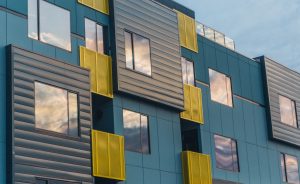
C-PACE finances EE improves for commercial and multifamily buildings
By now, many people in this industry have at least heard of Commercial Property Assessed Clean Energy, or C-PACE. Across the Mid-Atlantic region, VAEEC and other stakeholders, including the Mid-Atlantic PACE Alliance, or MAPA, have been working diligently to accelerate the implementation of C-PACE programs and projects. Through this work, over $50 million of C-PACE projects have been financed across the region since January 2017.
C-PACE is a voluntary special assessment that is added to a property’s real estate tax bill. It provides building owners with a means to finance energy efficiency, water conservation, renewable energy, stormwater management, and resiliency projects for new and existing commercial, industrial, multifamily (with five+ dwellings), and nonprofit properties.
C-PACE is more advantageous than traditional financing by providing 100% financing, no upfront cash investment, and immediate savings. In fact, many projects are cash-flow positive from day one.
Benefits of C-PACE
- Increased building value
- Reduced utility bills
- More comfortable space with improved air quality
- 100% financing: no upfront cash investment required
- Long-term loans up to 25+ years: lower annual payments, positive cash flow
- Repaid as a Special Assessment on the Real Estate Tax Bill
- Transferable: the loan stays with the property upon sale
- Non-accelerating
- Can fill a gap in the capital stack
- Contributes to economic development, local job creations, and improved public health
How C-PACE differs from traditional financing options
| Traditional Construction Loan | C-PACE Assessment |
| Purpose | HVAC and Lighting | HVAC and Lighting |
| Project Cost | $100,000 | $100,000 |
| Loan | $75,000
25% upfront cash investment required | $100,000
0% upfront investment required |
| Interest Rate | 5% | 6.25% |
| Term | 5 years, fully amortizing | 15 years, fully amortizing |
| Monthly Payment | $1,415 | $857 |
| Annual Payment | $16,984 | $10,290 |
What role does the lending community play?
Funding for C-PACE projects comes from private capital providers, including local, regional, and national banks and investors. Capital providers or lenders approve the financing eligibility and underwriting for the project. They even have the ability to act as the project originator and can assist the owner with obtaining mortgage holder consent.
How does C-PACE benefit the lending community?
- This fairly new financing mechanism provides lenders and capital providers with new funding opportunities.
- C-PACE provides a good fixed rate of return without the property owner needing to refinance or incur additional transaction costs.
- The ability to transfer the C-PACE assessment to a new owner upon sale provides the current owner with an incentive to make building improvements now.
How are mortgage lenders involved?
Since C-PACE is secured by a special assessment, a corresponding lien is placed on the property. This is similar to how localities fund public infrastructure projects, such as sewers. The assessment is senior to all commercial liens, including mortgages. Therefore, property owners must obtain consent from their mortgage lender before the project can be approved.
To date, over 200 mortgage lenders across the nation have consented to C-PACE assessments for a variety of reasons. In partnership with MAPA, VAEEC has put together a directory of mortgage lenders who have consented to C-PACE in the Mid-Atlantic region. If you are looking to utilize C-PACE financing, you can check this directory to see if your mortgage lender is on the list.
Don’t see your mortgage lender listed? MAPA has put together a guide highlighting the top six reasons a mortgage lender would consent to a C-PACE assessment. The Case for Lender Consent: A C-PACE guide for mortgage lenders & property owners is an excellent way to engage your property’s senior lender(s) to assess their receptiveness to C-PACE early on in the project.
Stay tuned to learn more! MAPA will be holding a webinar, Financing C-PACE with Regional and Local Lending Partners, in the near future.
The 2020 General Assembly session marked a monumental shift in energy policy in the state, with multiple bills successfully pushing towards a cleaner, carbon free Virginia. Below, we highlight five bills that advance energy efficiency opportunities in the Commonwealth.
The most notable piece of clean energy legislation that passed the General Assembly this year is the sweeping Virginia Clean Economy Act (VCEA), carried by Delegate Rip Sullivan and Senator Jennifer McClellan. This landmark law will pave the way for a carbon-free Virginia by 2045, ensuring investments in energy efficiency, solar, wind, and more. The VCEA mandates 5% energy savings from the investor-owned utilities by 2025, with the State Corporation Commission (SCC) determining future savings in three-year blocks, marking Virginia as just the second state in the Southeast to establish a mandatory stand-alone Energy Efficiency Resource Standard (EERS).
 Based on our own analysis, the goals set forth in the VCEA are achievable. As part of our pre-filed testimony in support of Dominion’s Demand Side Management (DSM) Filing, we looked at Dominion’s current energy efficiency programs and their proposed programs to find a baseline for existing energy savings. We determined that, even using conservative estimates as only three years of data were available, Dominion would exceed the 2022 target of 1.25%. Additional analysis by ACEEE indicates that these targets translate to an average of 1.3% savings per year, which would put Virginia in the top 15 states nationwide in terms of utility savings targets.
Based on our own analysis, the goals set forth in the VCEA are achievable. As part of our pre-filed testimony in support of Dominion’s Demand Side Management (DSM) Filing, we looked at Dominion’s current energy efficiency programs and their proposed programs to find a baseline for existing energy savings. We determined that, even using conservative estimates as only three years of data were available, Dominion would exceed the 2022 target of 1.25%. Additional analysis by ACEEE indicates that these targets translate to an average of 1.3% savings per year, which would put Virginia in the top 15 states nationwide in terms of utility savings targets.
Additionally, the VCEA removes the automatic opt out for industrial customers above 500kW, which was instituted as part of the Grid Transformation and Security Act of 2018. Instead, it creates a verified, self-direct program which allows industrial customers above 1MW to opt out only after providing measured and verified savings data to the SCC from their own energy efficiency programs. VAEEC and many member organizations participate in an energy efficiency stakeholder group, which will leverage our ability to identify and maximize the programs that will best meet these customers’ needs. Programs geared towards these large industrial users will go even further towards the savings goals in the VCEA.
The Virginia General Assembly also passed legislation to allow Virginia to join the northeast Regional Greenhouse Gas Inventory (RGGI) as the first southern state to do so. The legislation allocates 50% of the money from the carbon trading regime to the Department of Housing and Community Development for low-income energy efficiency programs, including public housing upgrades and new construction incentives.
Thanks to legislation carried by Senator David Marsden, electric cooperative members will soon have the opportunity to afford energy efficiency upgrades to their homes via an on-bill tariff. The Pay-As-You-Save (PAYS) model has successfully been implemented in other electric coop territories nationwide and Rappahannock Electric Cooperative in Virginia hopes to be the first Virginia coop to offer it in the near future.
Other notable legislation that passed included two bills by Senator Scott Surovell. One bill now requires the Virginia Residential Disclosure Act to include an energy audit as an option for homeowners and buyers during the home buying process. The other legislation will require each state agency to designate an energy manager and begin tracking energy and water consumption at 100% of state-owned buildings by 2025. Public buildings are largely ineligible for energy efficiency programs and funds, so establishing a baseline for their energy use is critical to future savings.
The General Assembly also has the opportunity in the next few years to elect two new commissioners to the SCC, which presents greater opportunities for the expansion of clean energy- including energy efficiency- in Virginia.
The actions taken by the 2020 General Assembly will catapult Virginia into the top half of states in the country on the ACEEE scorecard. It will be up to the energy efficiency industry to ensure that savings from these programs are realized in order to continue climbing in the rankings. The VAEEC and our members will continue to monitor and take part in implementation efforts to ensure that Virginia maintains our new standing as an energy efficiency leader in the southeast.
Families everywhere are navigating the unique challenges of working, schooling, and just living at home. While energy use isn’t at the top of many people’s minds during a pandemic, all of the computers, streaming, hot showers and extra dishes add up to higher bills. Hear from VAEEC Office Manager Rebecca Hui and her daughters, “K” (age 10) and “A” (age 6), about energy use in the time of coronavirus.
 Rebecca: We’re all working in the same room most of the day. What is something we can each do to use less electricity while we’re at home?
Rebecca: We’re all working in the same room most of the day. What is something we can each do to use less electricity while we’re at home?
K (10): When we’re in one area of the house, so say we’re in the front section, we can keep the lights on in here, but in the back, we should turn the lights off. Except maybe in the kitchen.
A (6): Yeah because we frequently go in the kitchen for snacks. And maybe not using all of the computers all at one time.
K (10): We should turn off the computers when we’re finished, and if they’re fully charged, don’t keep them plugged in.
Rebecca: What do you think energy efficiency means?
A (6): To save energy and be efficient.
K (10): So, like, it’s using less energy to get the same thing as when you use more energy. Right?
Rebecca: Why do you think it’s important to use less energy?
K (10): If we use less energy, it helps the environment because some forms of energy you use like oil is not great for the Earth and also we’re wasting it.
A (6): So then we can save up energy for when we actually need it. Then our lightbulbs won’t run out because we will need them the next day.
Rebecca: How would you tell your friends to save energy?
K (10): Turn off the light when you leave a room.
A (6): I have a way. Turn off lights, and when you’re done with your computers, shut them down and turn them off.
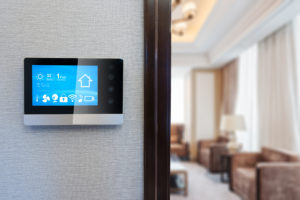 Rebecca: What about other grown ups? What can they do?
Rebecca: What about other grown ups? What can they do?
A (6): When you’re done with your work, when you’re not using something, unplug it and put it away.
K (10): For a lot of grown-ups, turn off your computers. Oooh! And buy LED light bulbs and a smart thermostat.
Rebecca: What is your favorite thing to do that doesn’t use a computer or TV?
A (6): I know! Reading a paper book. My other idea is drawing. I also like to observe flowers and ride my bike.
K (10): I like sewing and crocheting. Outside, I like roller skating.
Rebecca: What is one thing I always say to you?
A (6): Close the door.
K (10): Turn off the lights upstairs!
2020
Week 9: Final 2020 Legislative Update
Happy Monday, members! At long last, the General Assembly Session has come to an end. It’s fair to say that this has been the most intense and momentous session for energy policy in decades, and we are incredibly happy to be a part of the progress.
As we reported on Friday, SB 851, the Virginia Clean Economy Act, has PASSED! The bill has received media coverage in the Washington Post and GreenTech Media, and you can read our press release on this landmark legislation in our press room. The VCEA mandates 5% energy savings by 2025, with the SCC determining future savings in three-year blocks. The VCEA also removes the automatic opt out for industrial customers above 500kW and instead allows industrial customers above 1MW to opt out only after they have proven to the SCC that they are achieving energy savings through their own energy efficiency programs.
So what does that mean for the overlapping and/or conflicting bills that were heard in Session?
- HB 1526, the House version of the VCEA, passed through Conference with language identical to its Senate counterpart (SB 851).
- HB 1576 (Industrial opt-out) and HB 575 (EE stakeholder group) were both passed by the General Assembly, but as their language mirrors part of the VCEA, they will be subject to an internal review by the Governor’s office during the veto period.
- HB 1450 (standalone EERS) never made it to conference before the end of Session, as that language was identical to the VCEA.
We are excited to share that the following bills have also passed:
SB 754 provides a regulatory framework for electric cooperatives to seek approval from the State Corporation Commission to establish an On-Bill Tariff program for customers who want to perform energy efficiency upgrades to their residences. The cooperatives are already preparing for next steps on this program and have asked VAEEC to play a role in establishing the mandated stakeholder process, which we will keep our members apprised of.
SB 963 requires each state agency to track energy and water consumption at 100% of their facilities by 2025. This goal was set at 80% by 2025 before leaving the Senate but was changed back to 100% when it left the house. It is possible that the Governor will amend this bill to change it back to 80%. VAEEC member, U.S. Green Building Council was instrumental in getting this bill passed and has secured in-person training opportunities for Virginia state agencies from staff at EPA’s Energy Star program.
HB 518 and SB 628 ensure that energy audits will now be listed in the VA Residential Disclosure Act as an option for homebuyers during the homebuying process. These bills have already been signed by the Governor.
After receiving the Governor’s signature, all bills will take effect on July 1st.
Thank you to everyone who cheered on these bills, whether at the General Assembly or on the sidelines. We are committed more than ever to ensuring that the promising future laid out in this legislation becomes a reality. Don’t miss our Spring 2020 Forum on May 14th. We’ll discuss the effects of the new legislation and how members can stay engaged on these issues in our opening plenary panel.
Week 8
Happy Friday, members! As we turn the corner to the last week of Session, there’s still plenty of movement around energy efficiency to report.
The two conflicting versions of the VA Clean Economy Act – HB 1526 (Sullivan) and SB 851 (McClellan) – are going to a Committee of Conference to reach a compromise next week. A Committee of Conference is made up of three Delegates and three Senators. Two of the Delegates and two of the Senators will come from the majority party, and one will come from the minority party. We are keeping a close eye on this process to ensure that the energy efficiency piece of the bill remains strong.
HB 1450 (Sullivan), the stand-alone EERS bill, was passed through the Senate with a substitution that was ultimately rejected by the House. This bill will also go to a Committee of Conference, though it is currently unclear if it will be the same Conference as the VCEA.
On to the good news:
SB 754 (Marsden) unanimously passed both chambers and is ready to be signed into law! This bill provides a regulatory framework for electric cooperatives to seek approval from the State Corporation Commission to establish an On-Bill Tariff program for customers who want to perform energy efficiency upgrades to their residences.
HB 575 (Keam) passed the Senate with a substitution. This bill will expand the scope of the SCC energy efficiency stakeholder group. If the House accepts the substitution, this bill will also be ready to sign into law.
HB 1576 (Kilgore) unanimously reported out of the Senate Commerce and Labor committee. This bill raises the limit for industrial customers to opt-out of energy efficiency programs.
SB 963 (Surovell) has been referred to the House Appropriations committee. This bill establishes the Efficient and Resilient Buildings Board to advise the Governor on ways to accelerate improvements to state buildings in order to reduce greenhouse gas emissions.
As we stated last week, HB 518 (Bulova) and SB 628 (Surovell) have passed through both chambers. Both bills ensure that energy audits will now be listed in the VA Residential Disclosure Act as an option for homebuyers during the homebuying process.
While they are not bills we formally endorse, we are happy to share the passage of HB 981 (Herring) and HB 654 (Guy). HB 981, the Clean Energy and Community Flood Preparedness Act, commits Virginia to joining the Regional Greenhouse Gas Initiative (RGGI), while HB 654 establishes a state-wide administrator for C-PACE. These bills mark excellent progress towards a clean energy future.
Week 7
Happy Friday, members! It’s been another busy, whirlwind week in the General Assembly, though not quite as momentous as the past two. Before we launch into this week’s recap, we have an urgent action item: HB 1450 (Sullivan), the stand-alone EERS bill, is being heard in the Senate TODAY. We need all of you to call or email your Senators and voice your support for this legislation. HB 1450 establishes mandatory savings targets for Virginia’s investor-owned utilities based on 2019 retail sales to help Virginia families save money on their electricity bills. If you’re not sure who your legislator is, or how to contact them, use this handy tool from the GA website.
Moving onto this week’s updates. We’re excited to announce that HB 518 (Bulova) and SB 628 (Surovell) have passed through both chambers and are headed to the Governor’s desk! Both bills ensure that energy audits will now be listed in the VA Residential Disclosure Act as an option for homebuyers during the homebuying process.
SB 754 (Marsden) unanimously reported out of the House Labor and Commerce committee. This bill provides a regulatory framework for electric cooperatives to seek approval from the State Corporation Commission to establish an On-Bill Tariff program for customers who want to perform energy efficiency upgrades to their residences.
SB 963 (Surovell) reported out of the House General Laws subcommittee on Professions/Occupations and Administrative Process, as well as the full General Laws committee. It has not been referred to the House Appropriations subcommittee on Compensation and General Government. This bill establishes the Efficient and Resilient Buildings Board to advise the Governor on ways to accelerate improvements to state buildings in order to reduce greenhouse gas emissions.
As for the VA Clean Economy Act and its various components, we anticipate all of those bills being heard in the Senate Commerce and Labor committee on Monday- HB 1526 (Sullivan, House version of VCEA), HB 1576 (Kilgore, Industrial opt-out), or HB 575 (Keam, expanding EE stakeholder group)– and SB 851 (McClellan, Senate version of VCEA), in the House Labor and Commerce committee next week.
Week 6
Happy Valentine’s Friday, members! If you’ve followed the news at all in the past week, you know there is really only one word to describe the past week: HUGE. The Virginia Clean Economy Act (VCEA) passed both the House and the Senate on Tuesday, marking a monumental shift in energy policy. VAEEC’s Executive Director has spent literally hundreds of hours in negotiations alongside clean energy business organizations and environmental advocates to get the landmark legislation passed. Delegate Sullivan, the bill’s sponsor in the House, said the VCEA will propel Virginia “into the future and into the top tier of states in terms of climate and energy policy.”
The bill has garnered national attention as well, having been featured in the New York Times, the Washington Post, the Virginian-Pilot, and Utility Dive. In our 2020-2022 Strategic Plan, we say Virginia is poised for revolutionary change. This week shows how true that is, and how far we have come as both a state and an organization. There are still hurdles ahead, as differences in the House and Senate versions of the bill must be reconciled before it can go to Governor Northam, but we are absolutely overjoyed at this enormous step towards a clean energy future.
And like that wasn’t enough good news for one week, there’s loads more to share:
The stand-alone EERS bill, HB 1450 (Sullivan) also PASSED the House, 75 to 24, with strong bipartisan support. It has now been referred to the Senate committee on Agriculture, Conservation, and Natural Resources, which is unusual, so we will be watching this closely. Additionally, VAEEC drafted a substitute for the patron to clean up some drafting errors and provide technical amendments, which have been reviewed by the investor-owned utilities and the coalition working on the broader VCEA.
HB 1576 (Kilgore) PASSED the House and has been referred to the Senate Commerce and Labor committee. This bill removes the automatic opt-out for industrial customers from paying for energy efficiency programs. It instead requires large consumers to prove their own energy savings before opting out of utility programs.
SB 754 (Marsden) unanimously PASSED the Senate and has been referred to the House Labor and Commerce committee. This bill provides a regulatory framework for electric cooperatives to seek approval from the State Corporation Commission to establish an On-Bill Tariff program for customers who want to perform energy efficiency upgrades to their residences.
SB 963 (Surovell) unanimously PASSED the Senate. It has been referred to the House General Laws subcommittee on Professions/Occupations and Administrative Process. This bill establishes the Efficient and Resilient Buildings Board to advise the Governor on ways to accelerate improvements to state buildings in order to reduce greenhouse gas emissions.
HB 575 (Keam) passed the House and has been referred to the Senate Commerce and Labor committee. VAEEC drafted a substitute for the patron to align with language in both the VCEA and the EERS bills.
HB 518 (Bulova) and SB 628 (Surovell) passed the House and Senate, respectively. Both bills have also already passed out of committees in the opposite chamber and are going to the opposite chamber floor for a vote ensuring that energy audits will now be listed in the VA Residential Disclosure Act as an option for homebuyers during the homebuying process
Also, while it is not a bill we formally endorse, we are happy to share that HB 654 (Guy) passed the House, putting Virginia one step closer to launching a statewide C-PACE administrator.
We hope you all have a wonderful weekend, celebrating that not only is love in the air, but progress is too.
Week 5
Last night, for the first time ever, a mandatory Energy Efficiency Resource Standard (EERS) passed out of the House Labor and Commerce Committee with bipartisan support. The EERS mirrored the energy efficiency components of the Virginia Clean Economy Act (VCEA), which also passed out of that committee. “To say this is monumental is an understatement,” says our Executive Director, Chelsea Harnish, who was in attendance for this historic vote. “There are still hurdles ahead, but the passage of both HB 1450 and HB 1526 through the full committee is a massive and critical step for energy efficiency. We’re incredibly excited to be part of that success.”

The House Labor and Commerce committee’s final vote on HB 1526, the Virginia Clean Economy Act.
Chelsea has been working tirelessly, in hours of negotiations with a coalition of advocates from across the clean energy industry, to ensure that the EERS significantly raises the bar for energy savings. The EERS will require Dominion to hit a 2.5% energy savings target by 2025, which speeds up the spending timeline on the $870M commitment in the GTSA. The VCEA will put Virginia in the top 5 for climate change policy nationwide, and will make the state’s ACEEE energy efficiency score leap to at least the top 20 in their annual scorecard.
The Senate Commerce and Labor Committee will hold a special meeting this Sunday and will review all energy bills at that time. As we lead up to Crossover on Tuesday, we will keep you updated on the progress.
Other Good News:
HB 1576 (Kilgore) reported unanimously out of the House Commerce and Labor committee.
HB 575 (Keam) passed the House.
HB 518 (Bulova) and SB 628 (Surovell) passed the House and Senate, respectively.
SB 754 (Marsden) reported unanimously out of the Senate Commerce and Labor committee with substitutions.
SB 963 (Surovell) reported unanimously out of the Senate Finance and Appropriations committee.
Week 4
Happy Friday, members! It was another very busy week in the General Assembly. Clean energy advocates have been negotiating with the utilities all week to reach a consensus on the Virginia Clean Economy Act (HB 1526/SB 851) and those negotiations continue today. As always, if you need a refresher on the bills we’re supporting, check out last week’s blog post.
Onto the good news! We are excited to announce that HB 518 (Bulova) passed the House on Tuesday with a vote of 86 to 13. SB 628 (Surovell) also passed the Senate last week.
HB 575 (Keam) was unanimously reported out of the House Labor and Commerce committee and is on the House floor for consideration.
SB 963 (Surovell) reported out of the Senate General Laws and Technology committee with amendments, and was referred to Finance and Appropriations.
Also, while this is not a bill the VAEEC formally supports, we are happy to state that HB 654 (Guy), which will authorize the Virginia Department of Mines, Minerals and Energy to establish a statewide C-PACE program, reported unanimously out of the Cities, Counties, and Towns Land Use subcommittee yesterday.
None of our other bills were heard in last night’s House subcommittee meeting. HB 1450 (Sullivan), HB 1526 (Sullivan), and HB 1576 (Kilgore) will all be heard on Tuesday in the final subcommittee meeting before Crossover.
SB 354 (Bell), SB 851 (McClellan), and SB 754 (Marsden) will be in the full Senate Commerce and Labor committee on Monday. We would love to see as many members as possible on Monday and Tuesday come out to show their support for these bills.
VAEEC continues to oppose SB 613 (Suetterlein). The bill was passed by indefinitely by the Senate Commerce and Labor committee this week.
Week 3
Happy Friday! This week was incredibly busy and we saw a lot of action around many EE bills. Before we get to business, there are several important dates coming up:
The Senate Commerce and Labor Energy subcommittee will hear their bills next Monday, and the House Labor & Commerce subcommittee #3 will hear theirs next Thursday. Wednesday is also the AEE Lobby Day in support of the Virginia Clean Economy Act. These are all great opportunities to make sure your voice is heard, so we hope to see lots of members at the General Assembly. For a review of the bills we’re following, check out last week’s blog post.
We are happy to announce that the VAEEC Board has voted to formally support the following bills:
New HB 1526 (Sullivan) and SB 851 (McClellan) – The Virginia Clean Economy Act. The Senate version will be heard next Monday in the energy subcommittee of Commerce and Labor. The House version will be heard next Thursday in the energy subcommittee of Labor and Commerce.
New SB 754 (Marsden) – Provides a regulatory framework for electric cooperatives to seek approval from the State Corporation Commission to establish an On-Bill Tariff program for customers who want to perform energy efficiency upgrades to their residences. This bill has been assigned to the energy subcommittee of Commerce and Labor.
New HB 1576 (Kilgore) – Increases the threshold for industrial consumers to opt-out of energy efficiency programs from 500 kW to 1 mW. This bill has been assigned to the energy subcommittee of Labor and Commerce.
HB 518 (Bulova) and SB 628 (Surovell) – We are excited to report that SB 628 passed the Senate on Tuesday 28 to 14. The House version reported out of the General Laws and Technology committee and is on the House floor for consideration.
HB 575 (Keam) – Was unanimously reported out of the energy subcommittee last night.
HB 1450 (Sullivan) and SB 354 (Bell)- The Senate version will be heard next Monday in the energy subcommittee of Commerce and Labor. The House version will be heard next Thursday in the energy subcommittee of Commerce and Labor.
SB 963 (Surovell)- This bill should be heard in General Laws and Technology next week and will be referred to the Finance Committee by request.
HB 413 (Delaney) – The House Committee on Cities, Counties and Towns – Land Use subcommittee voted to kill the bill.
VAEEC continues to oppose SB 613 (Suetterlein). Various amendments have been provided to the patron by various entities, some of which would resolve our concerns with this bill. However, the docket for Monday’s Senate Commerce & Labor committee meeting has not been published, so we will continue to follow this for future updates.
Week 2
UPDATE 1/17/2020 2:23 PM: The VAEEC Board has voted to officially support HB 1450 (Sullivan)/SB 354 (Bell), HB 413 (Delaney), and HB 575 (Keam).
Happy Friday! The second week of the General Assembly session saw a lot of activity, including a few new bills and plenty of information for our members. If you need a refresher on all the different bills that have been proposed, check out last week’s blog post and Wednesday’s legislative preview webinar.
At this time, the VAEEC Board and Policy Committee have voted to formally support HB 518 (Bulova), HB 574 (Keam), and SB 628 (Surovell). These bills add an energy audit analysis to the Residential Disclosure Act as an option for homebuyers to request during the home-buying process. HB 574 was rolled into HB 518, which unanimously passed out of subcommittee yesterday. SB 628 passed out of the full Senate committee on Wednesday and is now on the Senate floor for consideration.
The Board also voted to oppose SB 613 (Suetterlein). The bill prohibits all utilities and their affiliates from distributing “promotional” mail- both physical and electronic – to customers, including bill inserts, circulars, newsletters, and more. While the limitations of this bill may not have been intended by the patron, we feel it would curtail the ability to advertise and market utility energy efficiency programs.
The Policy Committee voted to recommend the following bills to the VAEEC Board for support. We are still pending Board approval at this time but will keep you apprised of future developments.
New SB 963 (Surovell)- Establishes the Efficient and Resilient Buildings Board to advise the Governor on ways to accelerate improvements to state buildings in order to reduce greenhouse gas emissions. The bill has been referred to the General Laws and Technology committee.
HB 1526 (Sullivan) and SB 851 (McClellan)- The Virginia Clean Economy Act. SB 851 has been referred to the Senate Commerce and Labor (C&L) committee. HB 1526 is pending referral to the House Labor and Commerce (L&C) committee.
HB 1450 (Sullivan) and SB 354 (Bell)- Establish a mandatory statewide Energy Efficiency Resource Standard (EERS). HB 1450 has been referred to L&C subcommittee #3, and there is no update on SB 354.
HB 461 (Sullivan) – Extends the property tax credit for renewable energy upgrades, which includes energy-efficient geothermal heat pumps. The bill has been referred to the House Finance Committee.
HB 413 (Delaney) – Includes provisions to establish minimum standards for energy efficiency, as well as maintaining access to renewables in subdivision ordinances. The bill has been assigned to the House Committee on Counties, Cities, and Towns (CC&T), Land Use subcommittee.
HB 575 (Keam) – Expands the scope of the SCC-mandated energy efficiency stakeholder process. The bill has been assigned to L&C subcommittee #3.
Week 1
Wednesday was the first day of the 2020 General Assembly session and it is shaping up to be a very busy one! The following energy efficiency bills have been introduced, but as of yet, VAEEC has not taken any official positions. The VAEEC Policy committee will meet next week to review bills and make recommendations to the VAEEC Board. We hope to announce official positions on some bills in next week’s update.
With the change in leadership at the General Assembly, we are seeing a great deal of interest in legislation that advance both energy efficiency and clean energy more broadly. To make it easier to find bills that you may find relevant, we are grouping legislation into themes below.
The Virginia Clean Economy Act/ Clean Energy Standards
HB 1526 (Sullivan) and SB 851 (McClellan)- The Virginia Clean Economy Act. If you have heard any news about clean energy legislation in the past few weeks, it’s most likely been about this massive, sweeping legislation. These bills establish a carbon-free by 2050 plan that aligns with Governor Northam’s EO 43, which includes a mandatory Energy Efficiency Resource Standard (EERS). Additionally, it establishes a mandatory Renewable Portfolio Standard, codifies the Governor’s carbon rule, and includes provisions for coastal resiliency, battery storage, and offshore wind.
HB 1450 (Sullivan) and SB 354 (Bell)- Establish a mandatory statewide Energy Efficiency Resource Standard (EERS) that would require annual incremental energy savings from investor-owned utilities based on the annual average retail sales of the previous three years. The language in this bill is identical to the EERS portion of the Virginia Clean Economy Act.
SB 876 (Marsden) – Establishes a mandatory Clean Energy Standard to meet the 2030 and 2050 goals laid out in Governor Northam’s EO43. However, this bill solely relies on renewables to reach those goals. It does not mandate energy savings targets or mention energy efficiency at all.
Carbon Rule Codification/ Regional Greenhouse Gas Initiative (RGGI)
While VAEEC has not taken a position on these types of legislation in the past, we have been more actively engaged this year in providing advice to bill patrons and the Governor’s office about the best ways to allocate funding for energy efficiency programs with the greater chance of passage this year.
HB 20 (Lindsey) – Codifies carbon rule, would use carbon cap and trade revenues to assist in resiliency, energy efficiency and renewable investments, as well as Southwest VA workforce training programs. This bill does not include a provision to join RGGI.
HB 981 (Herring) – Establishes a carbon cap and trade program with measures that are consistent with RGGI. The bill does not specify whether Virginia would join RGGI, however. The funds from this program would support coastal resiliency and floodwater management. This legislation is supported by Governor Northam.
HB 1152 (Lopez) – Establishes a carbon cap and trade program with the specific mandate that Virginia joins RGGI. The funds from this bill would establish an Energy Efficiency Fund, with 50% of the allowances going to general energy efficiency programs and 20% going toward low-income EE programs.
Tax Credits, Rebate Programs and Financing
HB 461 (Sullivan) – Extends the property tax credit for renewable energy upgrades, which includes energy-efficient geothermal heat pumps.
HB 633 (Willett) – Establishes a tax credit for energy-saving products.
HB 654 (Guy) – Establishes a clean-energy financing program to be administered by the VA Department of Mines, Minerals and Energy.
SB 634 (Surovell) – Creates the Energy Efficiency Subsidy Program, which provides subsidies for residential energy efficiency measures and establishes a rebate program for the lease or purchase of zero-emission vehicles.
SB 754 (Marsden) – Provides a regulatory framework for both investor-owned electric utilities and electric cooperatives to seek approval from the State Corporation Commission to establish an On-Bill Tariff program for customers who want to perform energy efficiency upgrades to their residences. The IOU programs would be limited to households who make less than $100,000 annually.
Other EE Bills
HB 413 (Delaney) – Includes provisions to establish minimum standards for energy efficiency, as well as maintaining access to renewables in subdivision ordinances. This bill could pave the way for newly-built smart communities.
HB 518 (Bulova), HB 574 (Keam), and SB 628 (Surovell) – Adds an energy audit as an option for homebuyers to consider as part of the homebuying process in the Virginia Residential Disclosure Act.
HB 547 (Delaney) – Establishes an Energy and Economy Transition Council to identify new economic development and job opportunities in areas that rely heavily on a fossil-fuel economy. After meeting with VAEEC members and staff, the patron has agreed to include clean energy representatives as members to the council.
HB 575 (Keam) – Expands the scope of the SCC-mandated energy efficiency stakeholder process. The language in this bill is identical to language in the Virginia Clean Economy Act.
HB 714 (Reid) – Updates language in the Virginia Energy Plan to align with Executive Order 43. While this bill does not currently conform to Senator Favola’s SB 94 (below), the intent is for the language in these two bills to be identical.
SB 94 (Favola) – Expands the scope of the Virginia Energy Plan to align with the Governor’s carbon-free by 2050 goals in EO43 and creates a stakeholder group to review these goals. After meeting with VAEEC members and staff, the patron has agreed to include clean energy representatives in the list of pre-approved stakeholders.
Don’t forget to register today for our legislative webinar next Wednesday, January 15th at Noon. There are also several upcoming lobby days, so mark your calendars. They will be held on January 14th, January 29th, and February 6th. We will share more information about these dates as it becomes available.
Virginia’s energy efficiency community gathered in Richmond on November 14th for the VAEEC Fall Forum & Awards Luncheon. A big thank you to our sponsors, speakers, awards finalists, and attendees for making this event a great success!
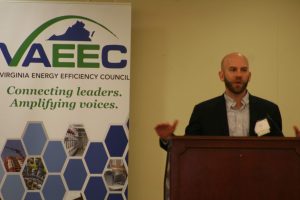
Keynote Speaker: Patrick Bean of Tesla
The event kicked off with an opening presentation from Executive Director, Chelsea Harnish. Attendees were updated on the organization’s newly released three-year strategic plan and 2019 accomplishments and updates. This portion of the event was followed by a keynote address from Tesla’s Patrick Bean. Patrick wowed the crowd by sharing Tesla’s vision for strategic electrification and the role energy efficiency plays in making that vision a reality. For example, Tesla engineers were able to increase the driving range of their Model X by 10% solely through the use of more efficient materials!
Afterward, participants headed to the first breakout session of the day where they could attend an hour-long panel, Energy Efficiency and Emerging Technologies, or two thirty-minute snap sessions, Utility Energy Efficiency Updates and Community Housing Partners’ Heat, Air, and Moisture (H.A.M) House Demo.
Energy Efficiency and Emerging Technologies: Back by popular demand, this session focused on up-and-coming innovations in the realm of energy monitoring, building controls, wastewater concentration, and home performance. Panelists also spoke about how their company works with the organizations in attendance and can help Virginia meet its energy goals. Speakers included Cynthia Adams (CEO and Co-Founder of Pearl Certification), Alexander Bazhinov (CEO and Founder of Lumin), and Karen Sorber (CEO of Micronic Technologies), and Marco Rubin (Senior Investment Director for the Center for Innovative Technology) moderated the panel. This session was sponsored by the Center for Innovative Technology.
Utility Energy Efficiency Updates: During the first snap session of the event, Virginia’s two largest investor-owned utilities, Dominion Energy and Appalachian Power Company (APCo), provided brief overviews on their current and proposed energy efficiency programs. Attendees were able to learn how their businesses can take advantage of these programs. Speakers included Michael Hubbard (Manager, Energy Conservation for Dominion Virginia / North Carolina Power) and Don Nichols (Manager of Energy Efficiency and Alternative Energy for APCo), and Susan Larsen (Director of Business Policy for Columbia Gas of Virginia) moderated the panel. Columbia Gas of Virginia sponsored this session.
H.A.M House Demo: Community Housing Partners’ (CHP) H.A.M House demonstrates how Heat, Air, and Moisture move through a building. Understanding these interactions is crucial in the design, building, and retrofitting of houses for higher efficiency and health and safety. VAEEC staff and Board were wowed by this demonstration last year during a visit to CHP’s training center, so we were thrilled to be able to present this opportunity to event attendees. This session was led by CHP’s Andrew Woodruff.
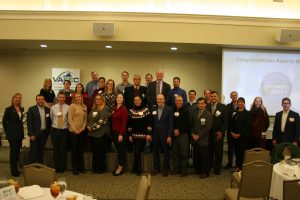
2019 VEEL Awards Winners
After a plated lunch, twelve Virginia-based projects or programs were recognized in the following categories: Academic, Commercial, Government, Low-Income, Residential, and Programs. We also presented the first-ever Founders’ Award to two of our founding members, Cynthia Adams of Peal Certification and Bill Greenleaf of Virginia Community Capital. This award honored their dedication to our work. For info on each winning project or program, visit our 2019 Awards page.
The second breakout session proceeded the Awards Luncheon. Participants chose to attend either the Preparing People for Progress in the Workforce panel or two snap sessions: 2020 Legislative Forecast and CHP’s H.A.M House Demo.
Preparing People for Progress in the Workforce: Growth in the clean energy industry is often stymied by the lack of available workers. This panel discussed the existing opportunities to foster the necessary skills in our communities, and how these programs can drive further changes. Speakers included Shawn Fenstermacher (General Manager for VEIC’s Mid-Atlantic Region), Mark Jackson (Executive Director at CHP), and Todd Estes (Virginia Community College System), and Carrie Webster (Energy Manager with Henrico County) moderated the panel. The session was sponsored by VEIC.
H.A.M House Demo: CHP’s Andrew Woodruff offered a second demonstration on how Heat, Air, and Moisture move through a building and how they affect our living environment.
2020 Legislative Forecast- What’s Next: During this snap session, attendees heard from two seasoned lobbyists on what the results of November’s election mean for the upcoming 2020 General Assembly session, as well as the probability for advancing legislation to help our industry grow. We were even able to provide attendees with a just-released, exclusive update on the new chairwoman of the Commerce and Labor Committee in the House. Speakers included Carmen Bingham (Affordable Clean Energy Project Coordinator with Virginia Poverty Law Center) and Andrew Vehorn (Vice President of Government Affairs for the Virginia, Maryland, and Delaware Association of Electric Cooperatives), and the panel was moderated by Chelsea Harnish (VAEEC). Old Dominion Electric Cooperative sponsored this session.
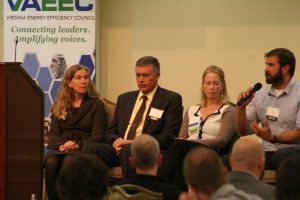
Speakers on the Final Panel discussing the relationship between EE and resiliency
After the breakout session, attendees enjoyed refreshments during the Networking and Snack break before heading into the last panel of the day, Exploring Energy Efficiency’s Role in Resiliency Efforts. Due to last-minute, unforeseen circumstances, Shelby O’Neil with Enterprise Community Partners and Joshua Saks from the Office of the Governor were unable to participate on the panel; however, two VAEEC Board members filled-in. The audience was treated to a candid discussion on what Virginia localities are doing in the realm of resiliency and how they can use Commercial Property Assessed Clean Energy to help finance resiliency measures. Speakers included Abby Johnson (Executive Director of Virginia PACE Authority and President of Abacus Property Solutions), Bill Eger (City of Alexandria) and Thomas Nicholas (City of Virginia Beach). VAEEC Board member Elizabeth Beardsley (USGBC) moderated.
Thank you to our sponsors, speakers, awards finalists, and event attendees for making this one of our best events to date. Click here to view photos of the event.
Mark your calendars! We hope to see everyone at our Spring 2020 Forum on Thursday, May 14, 2020 in Richmond.
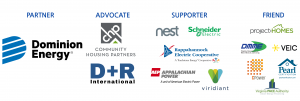


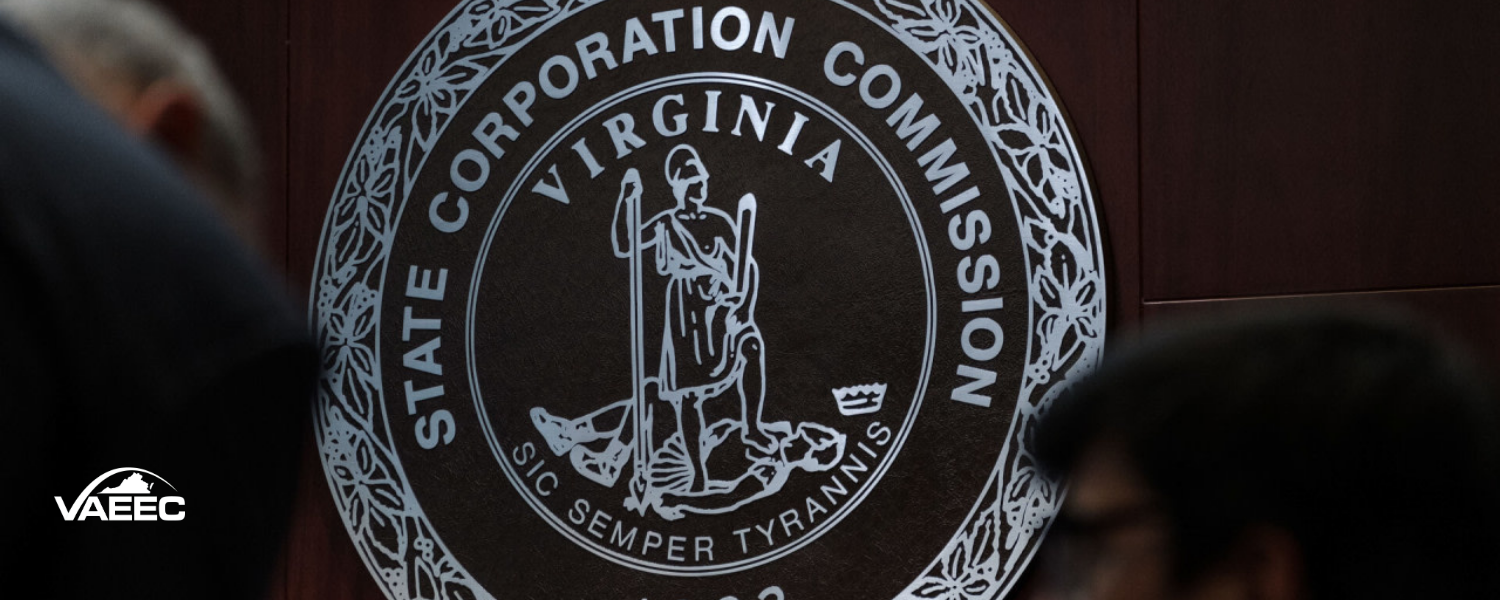
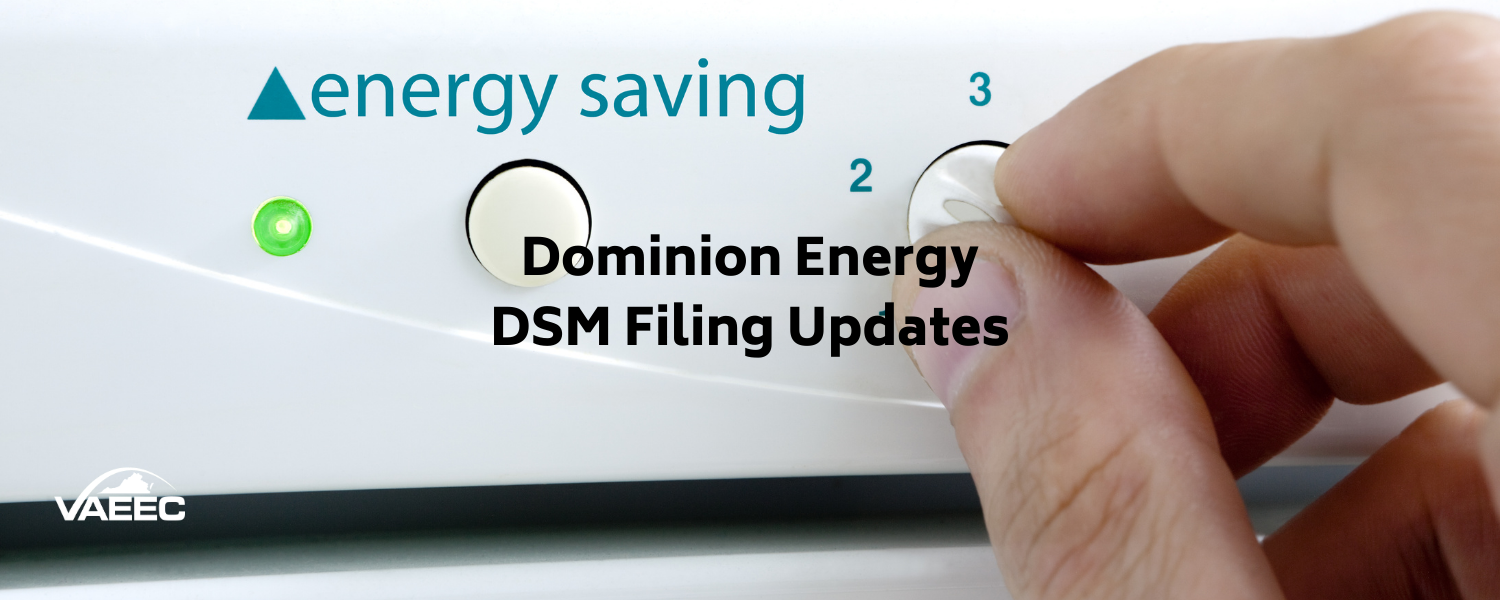
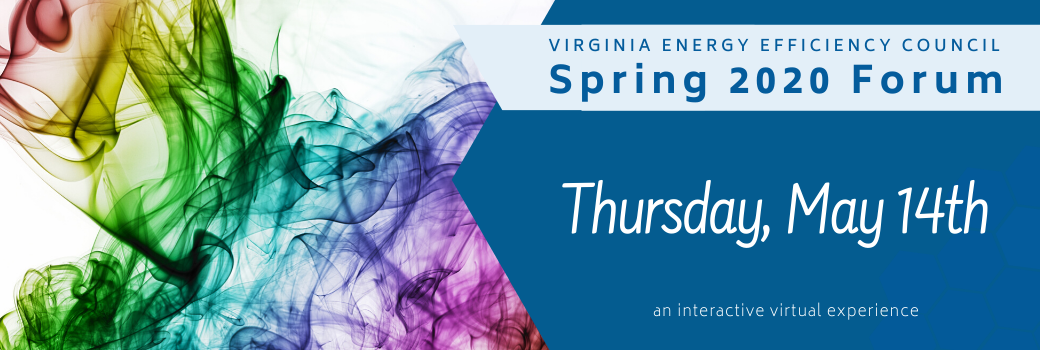
 Social distancing did not stop Virginia’s energy efficiency industry from coming together to learn and connect at our first-ever virtual Spring Forum. Over 100 energy efficiency professionals participated in the event, which included three educational sessions, our annual member meeting with Board elections, the fifth annual Virginia Energy Efficiency Leadership Awards, and a virtual networking break. Attendees were treated to topics such as the 2020 legislation, energy data, high-performance buildings, technology, and more. We want to extend a huge thank you to our sponsors for their support and to everyone who attended.
Social distancing did not stop Virginia’s energy efficiency industry from coming together to learn and connect at our first-ever virtual Spring Forum. Over 100 energy efficiency professionals participated in the event, which included three educational sessions, our annual member meeting with Board elections, the fifth annual Virginia Energy Efficiency Leadership Awards, and a virtual networking break. Attendees were treated to topics such as the 2020 legislation, energy data, high-performance buildings, technology, and more. We want to extend a huge thank you to our sponsors for their support and to everyone who attended.
